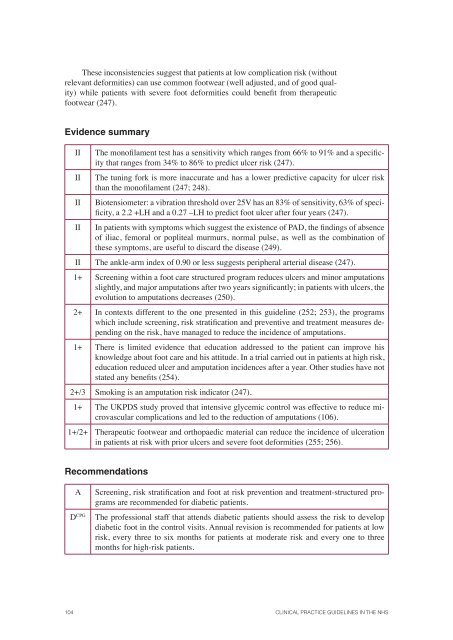2,46 Mb - GuÃaSalud
2,46 Mb - GuÃaSalud
2,46 Mb - GuÃaSalud
You also want an ePaper? Increase the reach of your titles
YUMPU automatically turns print PDFs into web optimized ePapers that Google loves.
These inconsistencies suggest that patients at low complication risk (without<br />
relevant deformities) can use common footwear (well adjusted, and of good quality)<br />
while patients with severe foot deformities could benefit from therapeutic<br />
footwear (247).<br />
Evidence summary<br />
II<br />
II<br />
II<br />
II<br />
The monofilament test has a sensitivity which ranges from 66% to 91% and a specificity<br />
that ranges from 34% to 86% to predict ulcer risk (247).<br />
The tuning fork is more inaccurate and has a lower predictive capacity for ulcer risk<br />
than the monofilament (247; 248).<br />
Biotensiometer: a vibration threshold over 25V has an 83% of sensitivity, 63% of specificity,<br />
a 2.2 +LH and a 0.27 –LH to predict foot ulcer after four years (247).<br />
In patients with symptoms which suggest the existence of PAD, the findings of absence<br />
of iliac, femoral or popliteal murmurs, normal pulse, as well as the combination of<br />
these symptoms, are useful to discard the disease (249).<br />
II The ankle-arm index of 0.90 or less suggests peripheral arterial disease (247).<br />
1+ Screening within a foot care structured program reduces ulcers and minor amputations<br />
slightly, and major amputations after two years significantly; in patients with ulcers, the<br />
evolution to amputations decreases (250).<br />
2+ In contexts different to the one presented in this guideline (252; 253), the programs<br />
which include screening, risk stratification and preventive and treatment measures depending<br />
on the risk, have managed to reduce the incidence of amputations.<br />
1+ There is limited evidence that education addressed to the patient can improve his<br />
knowledge about foot care and his attitude. In a trial carried out in patients at high risk,<br />
education reduced ulcer and amputation incidences after a year. Other studies have not<br />
stated any benefits (254).<br />
2+/3 Smoking is an amputation risk indicator (247).<br />
1+ The UKPDS study proved that intensive glycemic control was effective to reduce microvascular<br />
complications and led to the reduction of amputations (106).<br />
1+/2+ Therapeutic footwear and orthopaedic material can reduce the incidence of ulceration<br />
in patients at risk with prior ulcers and severe foot deformities (255; 256).<br />
Recommendations<br />
A<br />
D CPG<br />
Screening, risk stratification and foot at risk prevention and treatment-structured programs<br />
are recommended for diabetic patients.<br />
The professional staff that attends diabetic patients should assess the risk to develop<br />
diabetic foot in the control visits. Annual revision is recommended for patients at low<br />
risk, every three to six months for patients at moderate risk and every one to three<br />
months for high-risk patients.<br />
104 CLINICAL PRACTICE GUIDELINES IN THE NHS

















